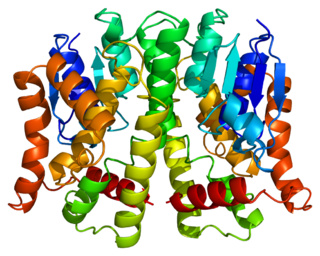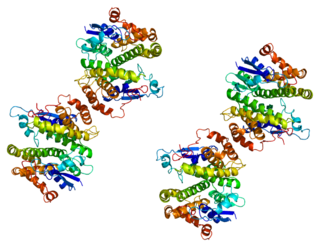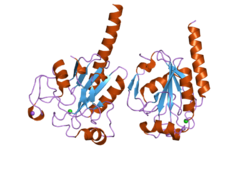
Glutathione peroxidase (GPx) is the general name of an enzyme family with peroxidase activity whose main biological role is to protect the organism from oxidative damage. The biochemical function of glutathione peroxidase is to reduce lipid hydroperoxides to their corresponding alcohols and to reduce free hydrogen peroxide to water.

Complement component 6 is a protein that in humans is encoded by the C6 gene.

Mannan-binding lectin serine protease 1 also known as mannose-associated serine protease 1 (MASP-1) is an enzyme that in humans is encoded by the MASP1 gene.

ATP-binding cassette sub-family C member 4 (ABCC4), also known as the multidrug resistance-associated protein 4 (MRP4) or multi-specific organic anion transporter B (MOAT-B), is a protein that in humans is encoded by the ABCC4 gene.

ATP-binding cassette, sub-family B member 11 (ABCB11), also known as the bile salt export pump (BSEP), is a protein which in humans is encoded by the ABCB11 gene.

Glutathione peroxidase 1, also known as GPx1, is an enzyme that in humans is encoded by the GPX1 gene on chromosome 3. This gene encodes a member of the glutathione peroxidase family. Glutathione peroxidase functions in the detoxification of hydrogen peroxide, and is one of the most important antioxidant enzymes in humans.

Peroxiredoxin-2 is a protein that in humans is encoded by the PRDX2 gene.

Glutathione S-transferase M3 (brain), also known as GSTM2, is an enzyme which in humans is encoded by the GSTM99 gene.

Glutathione peroxidase 2 is an enzyme that in humans is encoded by the GPX2 gene.

Glutathione S-transferase theta-2 is an enzyme that in humans is encoded by the GSTT2 gene.

Glutathione S-transferase Mu 4 is an enzyme that in humans is encoded by the GSTM4 gene.

Glutathione peroxidase 7 is an enzyme that in humans is encoded by the GPX7 gene.

Glutathione S-transferase A3 is an enzyme that in humans is encoded by the GSTA3 gene.

UDP-glucuronosyltransferase 2B17 is an enzyme that in humans is encoded by the UGT2B17 gene.

Glutathione S-transferase omega-2 is an enzyme that in humans is encoded by the GSTO2 gene.

Zinc transporter 1 is a protein which in humans is encoded by the SLC30A1 gene.

Glutathione peroxidase 5 (GPx-5), also known as epididymal secretory glutathione peroxidase is an enzyme that in humans is encoded by the GPX5 gene.

Glutathione peroxidase 6 (GPx-6) is an enzyme that in humans is encoded by the GPX6 gene.

IGF2 antisense RNA is a protein that in humans is encoded by the IGF2-AS gene.

Leiomodin 1 is a protein that in humans is encoded by the LMOD1 gene.























